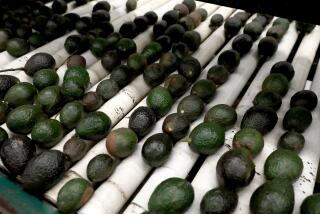Ex-Coca Farmers Fearful About Future
- Share via
LORO UNO, Colombia — In this valley where coca is king, Yanire Melo has instead staked her future on chocolate.
She is part of the largest project of its kind here in Guamuez Valley, where much of the world’s coca, the source of cocaine, was grown until U.S. crop dusters began blitzing the region with herbicide.
She has given up growing the profitable green weed to spend eight hours a day under a dark black tent the size of a football field, tending tiny plants that in two, maybe three years will produce cacao beans, the source of chocolate.
Coca makes more money. But Melo, whose coca crops were fumigated repeatedly, was desperate. “People are worried,” said Melo, a short, squat woman who works with 75 other families in the project. “They want to know how we’re going to make a living now.”
The U.S.-backed program to eliminate coca growth here has largely succeeded: Cultivation in coca-rich Putumayo has dropped 80% to 33,000 acres, according to a recent United Nations study.
But the U.S. and Colombian efforts to promote cultivation of rubber trees, cacao beans and timber as alternatives have had less success, according to interviews with local leaders, farmers and development experts in the region.
About 50,000 people have left Putumayo to grow and pick coca in other areas of Colombia. In Narino, a neighboring province, coca cultivation has nearly doubled to 37,000 acres.
Of those who have stayed, thousands of families have found temporary jobs in government programs that are designed to pave roads, build sewers or plant new forests to make up for land cleared of coca growing.
But there is still no long-term solution to turn this region from a coca-growing land into a place where ordinary people can make money doing ordinary jobs. Local people say that means coca eventually will return.
“Both coca and people are being displaced,” said Martin Munoz, the mayor in La Hormiga, a town in the center of Guamuez Valley. “When another place gets fumigated, everybody is just going to come back here.”
One of the biggest problems is the spraying itself. The government used to avoid spraying the land of those farmers who had signed pacts to pull up their coca in return for alternative development aid. But under President Alvaro Uribe, antinarcotics police have become more aggressive, spraying any plot of coca they discover.
That means that if one farmer continues to grow coca in a community where everybody else is trying to take advantage of the alternative development plans, the whole town could suffer the effects of spraying as the herbicide glyphosate drifts down.
Several families participating in a project to encourage a hearts-of-palm industry here had nearly 100 acres of new palm trees sprayed last year because they were growing near their neighbors’ coca fields, said Carlos Gavilanes, director of the project.
“This has caused serious problems. It’s out of control,” Gavilanes said. “We have one set of goals, and the antinarcotics police have another.”
U.S. officials argue that they have restructured the alternative development programs to make them work better. After alternative crop programs largely failed, most U.S. aid is now focused on building infrastructure. After a community agrees to pull up all its coca, contractors come in and use the local people to build new roads, sewers or health centers -- whatever the two sides have agreed upon during discussions. So far, such programs have resulted in more than 41,000 acres of coca being pulled up.
A U.S. official involved in alternative development dismissed concerns that such work is only temporary. The infrastructure itself, he said, would result in people finding jobs as it becomes easier to move produce to market.
“It’s not like they’ll all starve to death and pull up stakes and leave,” he said. “We’re not dealing with people who don’t know how to make a living farming.”
A bigger problem looms in the future. Alternative development plans have largely been concentrated here in Putumayo. But the fumigations have driven many people to plant coca in even more remote and less developed areas.
The province with the most coca now is Guaviare, a frontier area on the eastern plains that is mostly unsettled rain forest.
There, security problems because of the heavy presence of guerrillas, and the lack of almost all infrastructure -- roads, power and telephone service -- have discouraged any type of alternative development work. Farmers who have moved there are simply out of luck.
“Right now, the plan in Guaviare is just to spray them,” the U.S. official said. “We don’t have any longer-term development plans.”
More to Read
Sign up for Essential California
The most important California stories and recommendations in your inbox every morning.
You may occasionally receive promotional content from the Los Angeles Times.













